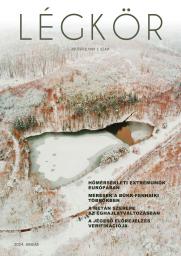LÉGKÖR - Quarterly Newsletter
Vol. 69, No. 1 * Pages 1–72 * January 2024
 |
|
 download [pdf: 41493 KB]
download [pdf: 41493 KB]
Symposium in memory of Gusztáv Götz for his 90th birthday anniversary
Szépszó Gabriella, Haszpra Tímea, Horányi András, Kalmár Tímea, Kristóf Erzsébet, Szintai Balázs, Tóth Helga
DOI:10.56474/legkor.2024.1.1 (pp. 2–11)
Szépszó Gabriella, Haszpra Tímea, Horányi András, Kalmár Tímea, Kristóf Erzsébet, Szintai Balázs, Tóth Helga
DOI:10.56474/legkor.2024.1.1 (pp. 2–11)
Education of new numerical modelling experts in meteorology
Szépszó Gabriella
DOI:10.56474/legkor.2024.1.2 (pp. 15–17)
Szépszó Gabriella
DOI:10.56474/legkor.2024.1.2 (pp. 15–17)
Methane: from ozone formation to climate change
Haszpra László
DOI:10.56474/legkor.2024.1.3 (pp. 18–24)
Haszpra László
DOI:10.56474/legkor.2024.1.3 (pp. 18–24)
The analysis of projected changes in temperature extremes across Europe based on the IPCC Interactive Atlas
Divinszki Ferenc, Kis Anna, Pongrácz Rita
DOI:10.56474/legkor.2024.1.4 (pp. 25–32)
Divinszki Ferenc, Kis Anna, Pongrácz Rita
DOI:10.56474/legkor.2024.1.4 (pp. 25–32)
Summary analysis of the 2022-2023 winter season based on the measurements in the Mohossinkhole and Vörösmeteor-sinkhole in Bükk-plateau
Dobos András, Kerékgyártó Róbert, Dobos Endre
DOI:10.56474/legkor.2024.1.5 (pp. 33–40)
Dobos András, Kerékgyártó Róbert, Dobos Endre
DOI:10.56474/legkor.2024.1.5 (pp. 33–40)
The verification of hail forecasts
Baár Péter, Csirmaz Kálmán, Kelemen Tibor
DOI:10.56474/legkor.2024.1.6 (pp. 41–47)
Baár Péter, Csirmaz Kálmán, Kelemen Tibor
DOI:10.56474/legkor.2024.1.6 (pp. 41–47)
Dezső Dévényi was born 75 years ago
Ihász István
LÉGKÖR - Quarterly Newsletter
A folyóirat nyomtatott változata megrendelhető a legkor@met.hu címen.
Kapcsolat: legkor@met.hu
SZERKESZTŐBIZOTTSÁG
SZERZŐI ÚTMUTATÓ
Kapcsolat: legkor@met.hu
SZERKESZTŐBIZOTTSÁG
SZERZŐI ÚTMUTATÓ









